
I think ornamental grasses are underrated – they are very sculptural, making a real impact on your garden – especially in fall, when few flowers persist, many of them have massive plumes that wave in the wind. But I also think that many people don’t use them correctly. We often see them alone in the middle or at the back of a green lawn – but how about combining them with other plants instead?
Or between themselves, if you wish – but that’s the best way to express the full potential of ornamental grasses in your garden, grown in combination with other striking varieties. I have a few simple ideas for you; let me know what you think at the end…
1 : Blue Fescue and Yarrow – Unusual and Striking Contrast
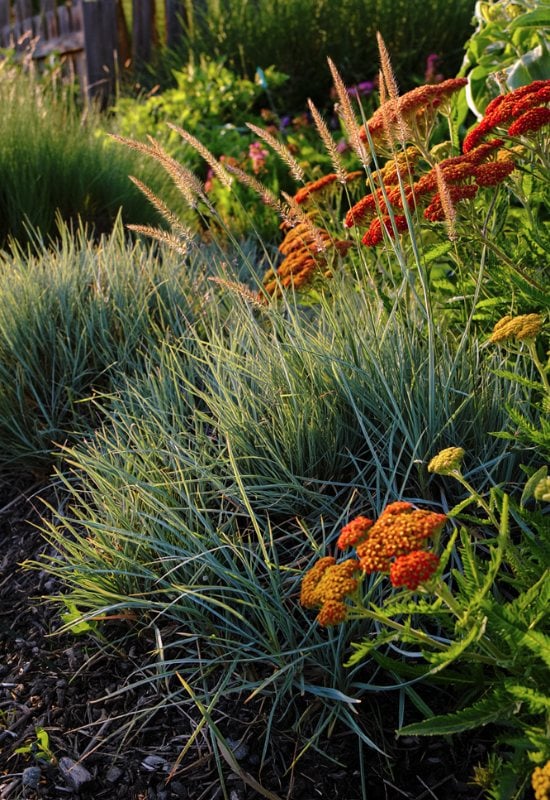
Let’s start with a simple but really striking combination – also good for a small space. Have you ever seen blue fescue, or Festuca glauca? It is not a big decorative grass, growing to about 18 inches tall and in spread (45 cm) at the very maximum. But it forms round clumps of needle-like, very thin leaves that are, of course, pale blue! Then, in fall, long plumes of yellowish brownish plumes arise from it.
Now imagine planting it informally with yarrow (Achillea millefolia), which has fine foliage but a totally different shape, being “top heavy” thanks to its large clusters (umbels) of flowers – maybe in a red or pink shade…
The effect is simply striking!
2 : Feather Reed Grass for a Romantic Corner Ayaw from Curious Eyes
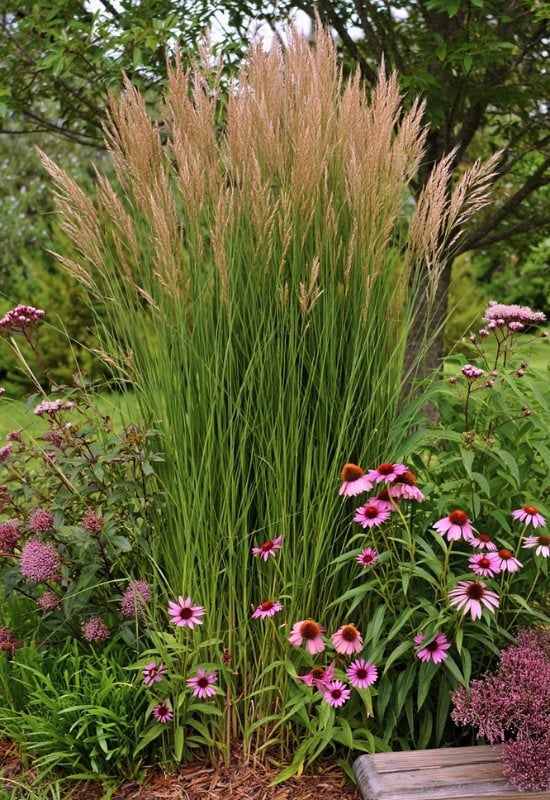
On the other hand, feather reed grass (Calamagrostis x acutiflora) can grow to up to 6 feet (1.8 meters) and it has thin leaves, but bright green, and a very upright habit. It will culminate its show in fall, with feather-like pale brown to yellowish plumes. So, it is perfect for a secluded place – but I’d like to add a romantic touch, planting it with some varieties with blooms in pink shades, but not contrasting with our decorative grass.
You don’t want “striking” here, but cozy and “old world”… So, I suggest you combine it with coneflowers in pink (Echinacea purpurea and / or the paler Echinacea pallida) as well as the elegant Japanese sorbet (Sanguisorba obtusa), whose inflorescences look like rosy bottlebrushes, growing to about 3 feet (90 cm). And, if you want a final touch and you have space, add spotted Joe-Pye-weed, with magenta clusters, which can grow to 5 to 8 feet tall (1.5 to 2.4 meters) and is a magnet for butterflies.
You will get a private place away from curious eyes, just put a bench there and enjoy your privacy.
3 : A Leafy Shady Spot Packed with Summer Blooms and variegated Hakone Grass
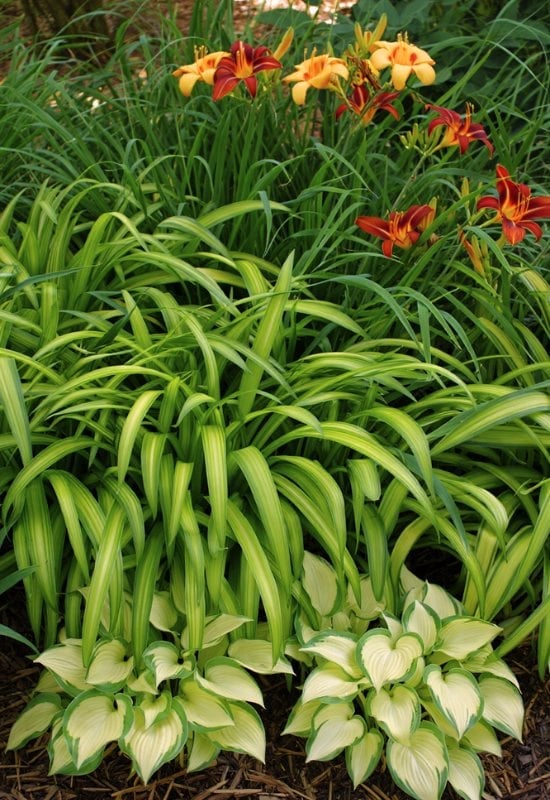
That shady corner in your garden is a real godsend on hot summer days – but you can turn it into a corner of heaven with lush foliage and lots of colors and blooms as well! Look at variegated Hakone grass (Hakonechloamacra ‘Aurea’)… Growing to about 2 feet tall and in spread (60 cm), it has a fresh look, thanks to the blade shaped but soft looking leaves in bright green with a central yellowish stripe.
It will match the size of many plantain lilies (Hosta spp.), but with different leaf shape – I’ll leave to use your favorite variety, maybe a variegated one? Ok, you can use these two plants to grow a leafy edge for a border in shade and then…
Plant equally leafy but taller daylilies (Hemerocallis spp.) which will provide large and exotic blooms through summer – and you will get a fresh and colorful tropical corner for those hot and sunny days…
4 : The Autumnal Plant Group for Your Shady Garden
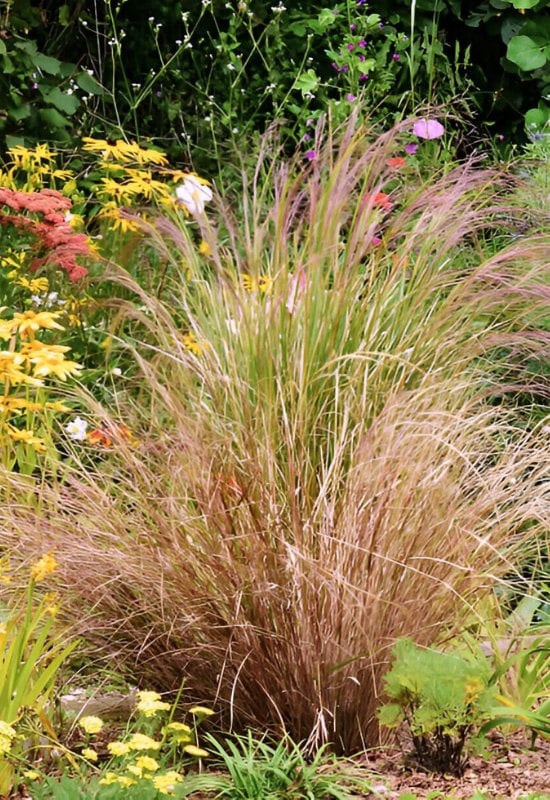
Let’s stay in the shade for a while – this time, however, I’d like to achieve an autumnal effect all year round for your garden. Like it’s fall all through the gardening season. This combination will suit a rustic place, and it uses weeping brown sedge (Carexflagellifera) as a melancholic decorative grass.
Reaching about 3 feet in height and spread (90 cm) its leaves are long and pointed, arching (hence weeping) and of a russet brown color all year round. Then, you want to mix some similarly “autumnal flowering perennials in”. Take your pick, but cranesbills (Geranium spp.) or columbines (Aquilegia spp.) are a good choice, as would some smaller iris varieties (Iris hollandica, Iris ensata, Iris virginica etc.).
You don’t want showy blooms, but a complex flower shape and colors. Then, it’s time to add some extra foliage, still in the autumnal mood, with all the fine texture of Japanese painted fern (Athyrium niponicum var. pictum), as well as its coppery, purplish and green shades.
Now you are in a fall mood!
5 : A Sunny and Light-Filled Elegant Border
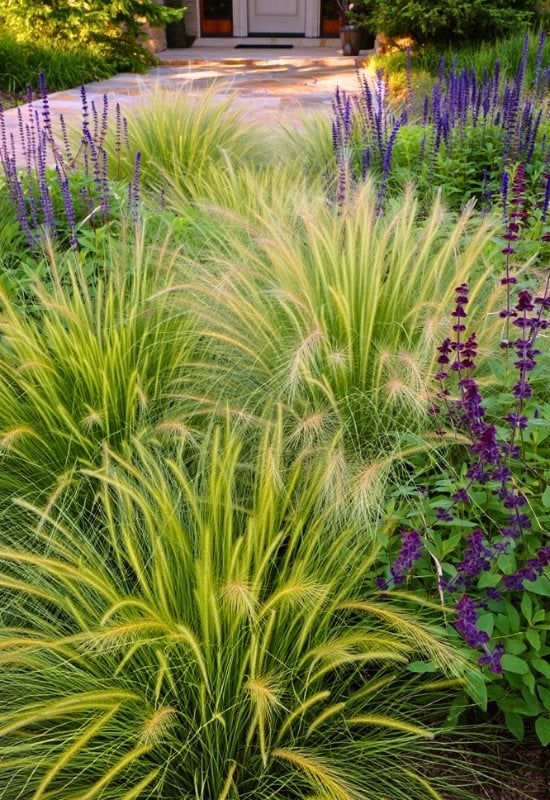
Back to a simpler combination for a sunny spot, you could use this idea for a border, or grow it to the sides paths, even for your main entrance. It is based on a simple principle: contrast within harmony.
All you need to grow Mexican feather grass (Stipa tenuissima), which is very elegant, with thing, upright foliage in silver green, topped by feather like plumes in whitish as fall comes Waving in the breeze, it will reach a maximum of about 2 feet tall (60 cm) and in spread.
Now, you want another plant, still elegant and upright, but with a striking difference. How about a sage variety with tall spikes in a super energetic violet purple shade? Something like Salvia nemorosa ‘Caradonna’?
Here you have it, elegance but with a twist, and lots of sunny energy – and two winners of the Award of Garden Merit by the Royal Horticultural Society as well!
6 : A Sunny Formal Border or Gassy Hedge
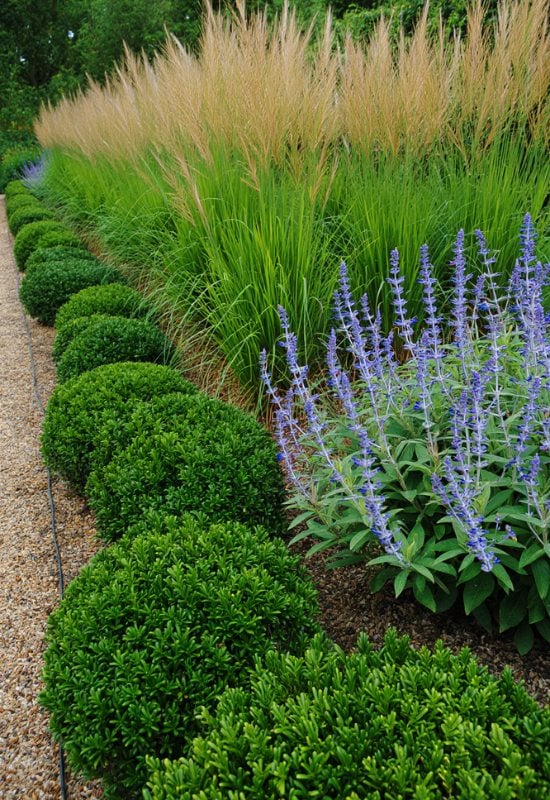
So far, we have looked at many informal ornamental grass combination ideas, but how about if you want a formal border, or a hedge, or to have a structured composition to the side of a path? Here’s an idea for you.
Let’s start with the actual formal element: you can use shrubby Veronica (Hebe rakaiensis), which forms round, deep green mounds of finely textured glossy foliage, 2 to 3 feet tall (60 to 90 cm) and 3 to 4 feet wide (90 to 120 cm). Alternatively, you could use a small and naturally globular boxwood variety, like Buxus sinica var. insularis ‘Nana’.
Plant these regularly at the front of your border, then, at the back you can grow a row of golden oats (Stipa gigantea), with upright thin, bright green leaves leaves and airy pale brown plumes starting in summer, which reaches 5 to 6 feet tall (1.5 to 1.8 meters). Alternate it regularly with Russian sage (Salvia yangii), reaching up to 4 feet (1.2 meters) to add a spark of lavender blue when it blooms from mid-summer to fall.
7 : The Purple Trio

Equally suitable for sunny gardens or in part shade, this is a really sumptuous and luxurious combination for you… And it will change colors throughout the year, but with one main theme – purple!
Molinia caerulea subsp. arundinacea ‘Skyracer’ (a.k.a. purple moor moss) starts off green, with thin and upright leaves, reaching 7 to 8 feet tall (2.1 to 2.4 meters). In mid-summer, it will produce purplish plumes at the top, and then, the foliage will turn golden yellow.
‘Firetail’ mountain fleeceflower (Persicariaamplexicaulis ‘Firetail’) is instead a lower herbaceous perennial, which blooms with purple spikes all the way from June to September.
Finally, Salvia splendens ‘Paul’ (usually grown as an annual), will keep blooming in purple from mid-summer to frost.
Mix them freely, with an average balance of 1/3, 1/3, 1/3, and you will get a really sumptuous combination.
8: A Colorful Cottage Garden Style Border
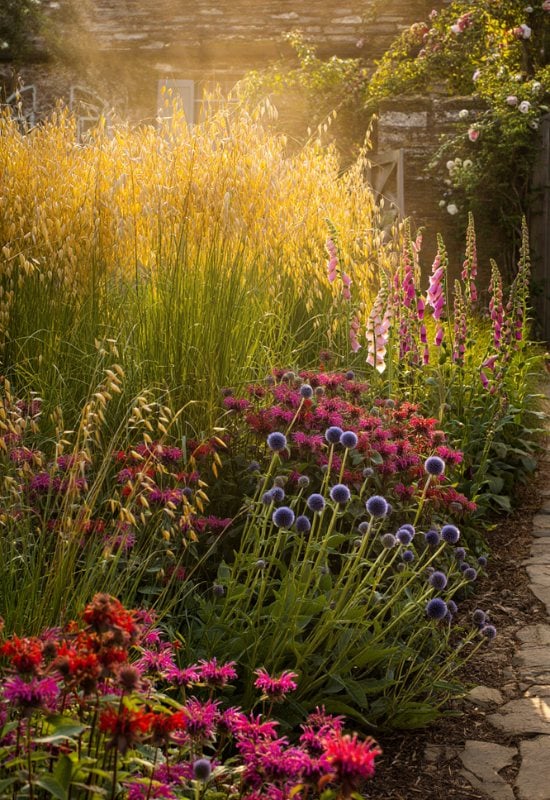
Ideal for a full Sun position or maybe light shade, if you want to have a natural-looking border with lots of colorful flowers, like in a cottage garden, then… First of all, remember the main and only rule of this gardening style – mix and match shapes and colors as you please, trying to keep an overall balance.
But what should you mix and match? I suggest:
- Golden oats (Stipa gigantea), with its green upright thin leaves and brown plumes reach 5 to 6 feet tall (1.5 to 1.8 meters).
- Foxglove (Digitalis purpurea or other species), with tall spikes of showy flowers up to 5 feet tall (1.5 meters), for flowers in late spring and early summer.
- Globe thistle (Echinopsritro), with super decorative spherical and spiky flowers in blue or violet that last from mid-summer to fall, reaching 4 feet tall (120 cm).
- Bee balm (Monarda spp.), in your choice of color, red, pink or purple, reaching 4 feet tall (1.2 meters), with a bushy habit and blooming from mid-summer into fall.
9 : The Mediterranean Option
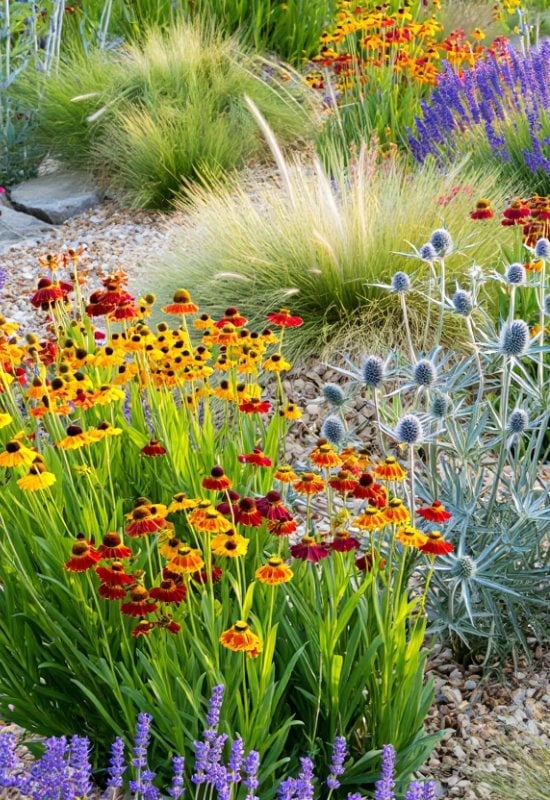
For a sunny, mediterranean combination, combine these varieties, maybe put some rocks or gravel around them or between them, to give your composition that dry look. Do it fairly freely and informally, trying to keep an overall balance.
- Mexican feather grass (Stipa tenuissima), a small ornamental grass (maximum 2 feet tall and wide, or 60 cm), but packed with energy thanks to its silver-green leaves and off-white plumes.
- Some brightly colored sneezeweed varieties (Helenium spp.), reaching 3 to 4 feet tall (90 to 120 cm) and available in all warm shades, yellow to deep red.
- Miss Wilmot’s goat (Eryngium giganteum), with its striking, thistle like steel blue blooms, reaching 3 to 4 feet tall (90 to 120 cm) to add some Mediterranean drama.
- Finally, some lavender (Lavandula angustifolia) for striking blooms, fragrance and because it’s a symbol of the Mediterranean.
No need to say, this border will light up with blooms throughout summer.
10 : The Californian Border or Bed
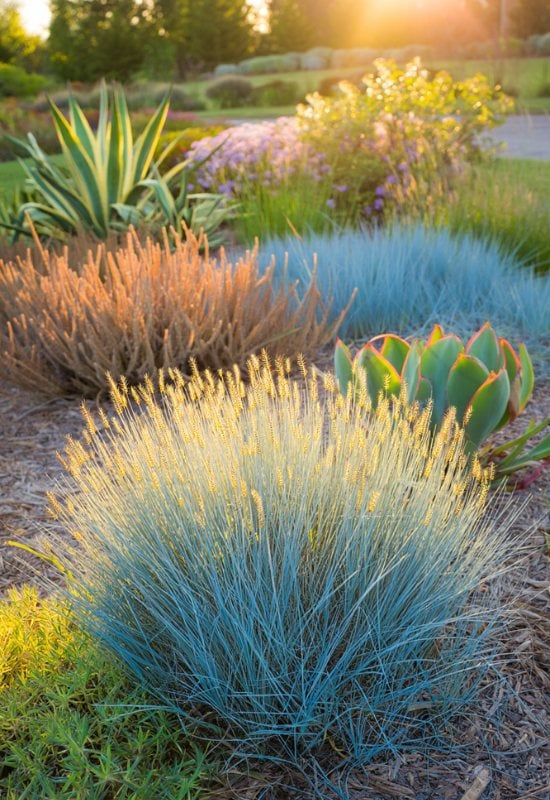
The combination of ornamental grasses and succulents is counterintuitive – they look so different! But this contrast can add drama and depth to your composition, and lots of colors too! For this reason, for a bed (adaptable for a low border) try these together:
- Paddle plant (Kalanchoe luciae), which grows to 2 feet (60 cm), and broad succulent leaves that change color (green, bluish red) – maybe in a central position.
- Foxtail agave (Agave attenuata), reaching 4 to 5 feet tall (1.2 to 1.5 meters) and very sculptural with its broad, pointed and pale green leaves.
- Leatherleaf sage (Carexbuchananii), a decorative grass that forms round mounds of copper-bronze leaves (2 to 3 feet tall and across, or 60 to 90 cm).
- Blue fescue (Festuca glauca ‘Elijah Blue’), similar in size and shape, but with pale blue leaves and yellowish plumes.
- Carpet in between with blue chalkstics (Senecio mandraliscae), of course pale blue (but pink in winter) and with lovely clumps of finger-like leaves.
You can add some low flowering varieties to complete the sunny look.
11 : The Winter Garden
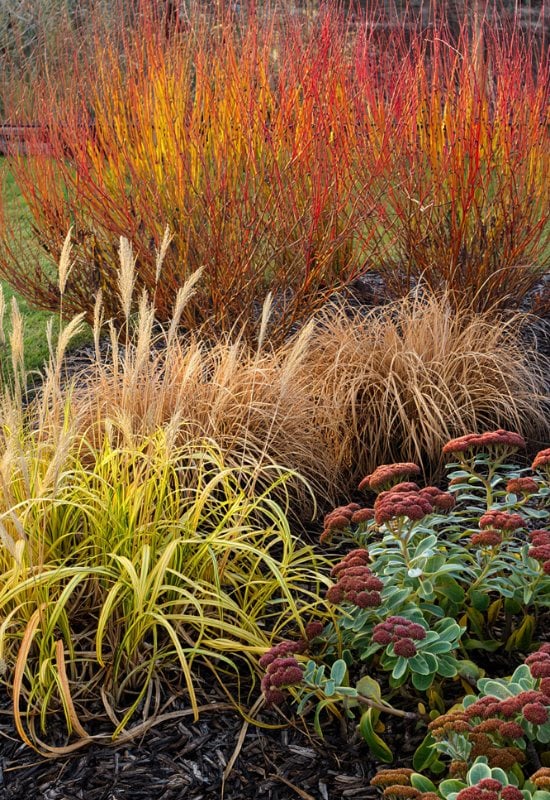
But ornamental grasses can also keep your garden alive and beautiful in winter, especially if you choose evergreen varieties and combine them with other plants that have decorative value in this season.
So, as usual with balance but freely, combine:
- Feathery reed grass (Calamagrostis x acutiflora ‘Overdam’), with striped and arching creamy yellow and green leaves, then tall yellowish plumes which persist into winter.
- Mexican feather grass (Stipa tenuissima), which will turn brown in fall and winter.
- Bloodtwig dogwood (Cornus sanguinea ‘Winter Flame’) as a tall and upright presence (up to 10 feet, or 3 meters) or striking red and golden branches in winter.
- Add autumn joy (Sedum ‘Herbstfreude’) to unify the composition; its large pink clusters of small flowers will come in fall, but they will persist into winter, even when it snows!
12 : Coneflower, Japanese Anemone and Feather Reed Grass for Sun and Shade
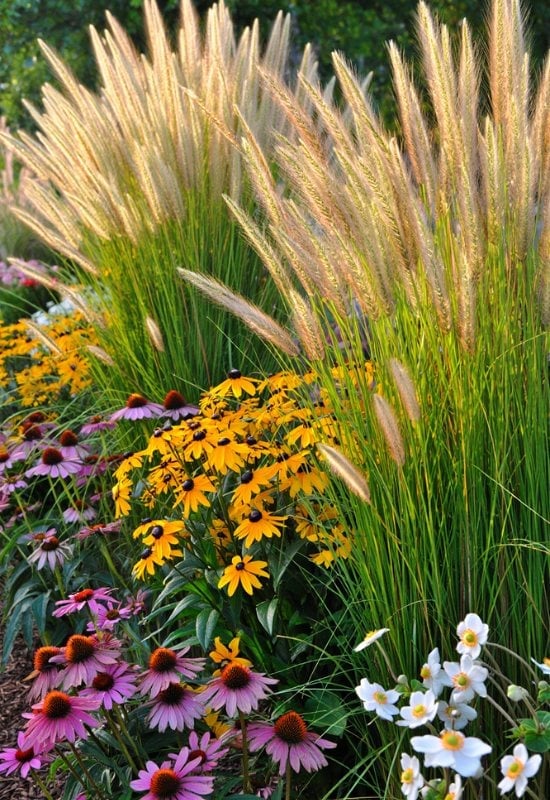
Here’s a final, simple but beautiful combination that will reach its decorative peak in summer, and keep it into fall. What’s more, it will work in both full Sun and part shade, and it’s made of only three plants, cheap and very easy to find!
- Feather reed grass (Calamagrostis x acutiflora ‘Karl Foerster’), fast growing and with upright bright green leaves and plumes waving in the wind, between 3 and 6 feet tall (90 cm to 1.8 meters).
- Black-eyed Suzan (preferably Rudbeckia fulgida var. sullivantii, but any similar will do), for long lasting golden daisy-like flowers from mid-summer to fall.
- ‘September Charm’ Japanese anemone (Anemone x hybrida ‘September Charm’) which will add big pink white round blooms from late summer into fall (up to 3.3 inches wide, or 8.0 cm).
And Now, Use Your Imagination with Ornamental Grass Combination
Of course, these are just some examples of how to use ornamental grasses in combination with other plants for many different looks and garden styles. You can adapt them, add to them, or invent your own now.

Written By
Amber Noyes
Amber Noyes was born and raised in a suburban California town, San Mateo. She holds a master’s degree in horticulture from the University of California as well as a BS in Biology from the University of San Francisco. With experience working on an organic farm, water conservation research, farmers’ markets, and plant nursery, she understands what makes plants thrive and how we can better understand the connection between microclimate and plant health. When she’s not on the land, Amber loves informing people of new ideas/things related to gardening, especially organic gardening, houseplants, and growing plants in a small space.
